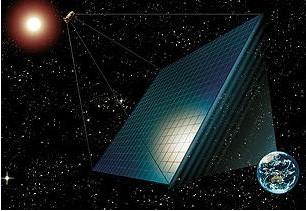(单词翻译:单击)

Science and Technology,Solar power from space,Beam it down, Scotty.
科技,从太空采集太阳能,传送电力到地球吧,斯科蒂。
Harvesting solar power in space, for use on Earth, comes a step closer to reality
将太空收获的太阳电能在地球上利用,这种理想又向现实迈出了一大步。
THE idea of collecting solar energy in space and beaming it to Earth has been around for at least 70 years.
从太空中收集太阳能并将其传送到地球的想法已经存在了至少70年。
In "Reason", a short story by Isaac Asimov that was published in 1941, a space station transmits energy collected from the sun to various planets using microwave beams.
艾萨克·阿西莫夫(Isaac Asimov )在1941年出版的短篇小说Reason中曾设想利用微波束将空间站收集到的太阳能传送到各类行星上。
The advantage of intercepting sunlight in space, instead of letting it find its own way through the atmosphere, is that so much gets absorbed by the air.
从太空直接截获太阳光而不任由它们穿过大气层的优点是大部分光能量不会被大气吸收。
By converting it to the right frequency first (one of the so-called windows in the atmosphere, in which little energy is absorbed) a space-based collector could, enthusiasts claim, yield on average five times as much power as one located on the ground.
通过将太阳光转换成正确的频率光波(即所谓的大气窗口之一,这种频率的光波在穿越大气层时能量损失最少),热衷该技术的人士称空间接收器产生的能量要比地面接收器平均高4倍。
The disadvantage is cost. Launching and maintaining suitable satellites would be ludicrously expensive.
但它的缺点是费用高。发射和维护合适的卫星将需要异常昂贵的费用。
But perhaps not, if the satellites were small and the customers specialised.
但如果它们是为客户专用的小型卫星,费用可能就不是问题。
Military expeditions, rescuers in disaster zones, remote desalination plants and scientific-research bases might be willing to pay for such power from the sky.
军事远征,灾区救援人员,远程海水淡化厂和各种科研基地都可能愿意为这种太空能源花付费用。
And a research group based at the University of Surrey, in England, hopes that in a few years it will be possible to offer it to them.
英国萨里郡(Surrey)大学研究小组希望在未来几年时间内可能将这种能源提供给客户使用。
This summer, Stephen Sweeney and his colleagues will test a laser that would do the job which Asimov assigned to microwaves.
今年夏天,斯蒂芬·斯威尼(Stephen Sweeney )及其同事将测试能够胜任这种工作的激光,用以取代阿西莫夫(Asimov)所指定的微波。
Certainly, microwaves would work: a test carried out in 2008 transmitted useful amounts of microwave energy between two Hawaiian islands 148km (92 miles) apart, so penetrating the 100km of the atmosphere would be a doddle.
当然,微波也能完成此项工作:2008年科研人员对微波做了实验,他们在两座相距148公里(92英里)的夏威夷岛屿之间成功地传送了大量微波能量,因此微波要穿透100公里的大气层也将是轻而易举的事。
But microwaves spread out as they propagate.A collector on Earth that was picking up power from a geostationary satellite orbiting at an altitude of 35,800km would need to be spread over hundreds of square metres.
但是微波在传播过程中会扩散,要想从轨道高度在35800公里的地球同步卫星上收集能量,地面能源接收器需涵盖几百平方米的范围。
Using a laser means the collector need be only tens of square metres in area.
而采用激光手段意味着能量接收器只需涵盖几十平方米的区域。
Dr Sweeney's team, working in collaboration with Astrium, a satellite-and-space company that is part of EADS, a European aerospace group, will test the system in a large aircraft hangar in Germany.
斯威尼(Sweeney)博士领导的研究小组与欧洲航空航天集团EADS下属的卫星与空间公司astrium合作研发,他们将在德国一座大型飞机库内对该系统进行测试。
The beam itself will be produced by a device called a fibre laser.
激光波束本身将由光纤激光设备产生并在一个细长的光纤核心产生激光束的相干光。
This generates the coherent light of a laser beam in the core of a long, thin optical fibre. That means the beam produced is of higher quality than other lasers, is extremely straight (even by the exacting standards of a normal laser beam)
这意味着产生的激光波比其它激光有更好的品质,并且直线度极高。(甚至符合正常激光束的严格标准)
and can thus be focused onto a small area.
这样就能将能量集中传送到一个小的区域范围内。
Another bonus is that such lasers are becoming more efficient and ever more powerful.
这种激光波的另一个优点是具有更高的效率和更强的能量。
In the case of Dr Sweeney's fibre laser, the beam will have a wavelength of 1.5 microns, making it part of the infra-red spectrum.
以斯威尼(Sweeney)博士研发的光纤激光器为例,它产生的激光波束波长为1.5微米,这使其成为红外线光谱的一部分。
This wavelength corresponds to one of the best windows in the atmosphere.
此波长对应于大气中的最佳窗口之一。
The beam will be aimed at a collector on the other side of the hangar, rather than several kilometres away.
实验中激光束的目标能量接收器不是位于几千米以外,而是放置在了飞机库的另一端。
The idea is to test the effects on the atmospheric window of various pollutants, and also of water vapour, by releasing them into the building.
其想法是把激光束释放到建筑空间来测试不同污染物和水蒸气对大气窗口的影响。
Assuming all goes well, the next step will be to test the system in space.
假如一切进展顺利,下一步该系统将送到太空中系统测试。
That could happen about five years from now, perhaps using a laser on the International Space Station to transmit solar power collected by its panels to Earth.
从现在算起,实验可能会在未来的五年内进行,可能采用的方法是利用国际空间站的激光将太阳板收集到的太阳能传送到地球。
Such an experimental system would deliver but a kilowatt of power, as a test.
作为测试,该实验系统将只传送一千瓦的电力。
In 10-15 years Astrium hopes it will be possible to deploy a complete, small-scale orbiting power station producing significantly more than that from its own solar cells.
Astrium希望在未来10到15年内,将有可能部署一个完整的、小规模的地球轨道电站,使其产生的电能远远超过自身太阳能电池产生的电能。
Other researchers, in America and Japan, are also looking at using lasers rather than microwaves to transmit power through the atmosphere.
美国和日本的其它研究人员也在寻求利用微波以外的激光透过大气传输能量。
NASA, America's space agency, has started using them to beam energy to remotely controlled drones.
美国航天局(NASA)已开始利用激光束将能量传送到远程无人驾驶飞机上。
Each stage of converting and transmitting power results in a loss of efficiency, but with technological improvements these losses are being reduced.
在电力转换和传送的各个阶段都会伴随效率的损失,但是随着科技的进步这些效率的损失正逐步减少。
Some of the latest solar cells, for instance, can covert sunlight into electricity with an efficiency of more than 40%.
例如最近开发的太阳能电池能以超过40%的效率将太阳光转换成电能。
In the 1980s, 20% was thought good.
但在20世纪80年代,20%的效率就被认为是不凡的表现了。
Whether the Astrium system will remain a specialised novelty or will be the forerunner of something more like the cosmic power stations of Asimov's imagination is anybody's guess.
是否Astrium的系统仍只是一种专业领域的新奇玩意或者会成为象阿西莫夫设想的宇宙发电站那样的科技先锋,一切都还是未知数。
But if it comes to pass at all, it will be an intriguing example, like the geostationary communications satellites dreamed up by Asimov's contemporary, Arthur C. Clarke, of the musings of a science-fiction author becoming science fact.
与阿西莫夫(Asimov)同时代的科幻小说作家阿瑟C.克拉克曾幻想过地球同步通信卫星的存在,这种幻想如今已变成了科学现实,与此相同,如果Astrium的系统实验能获成功,它也将成为将科学幻想变成现实的有趣范例。


